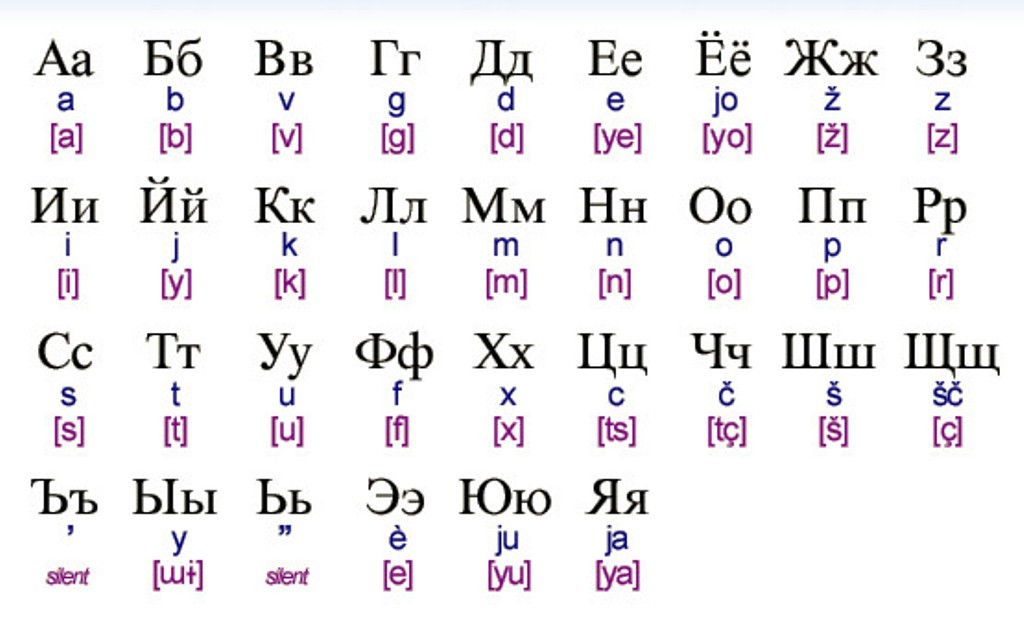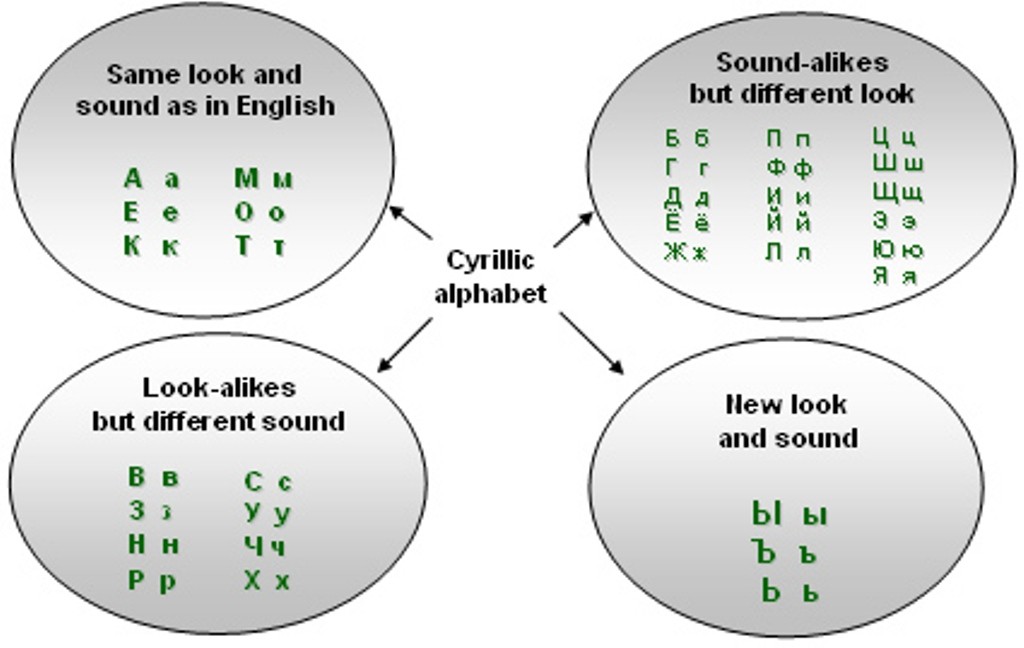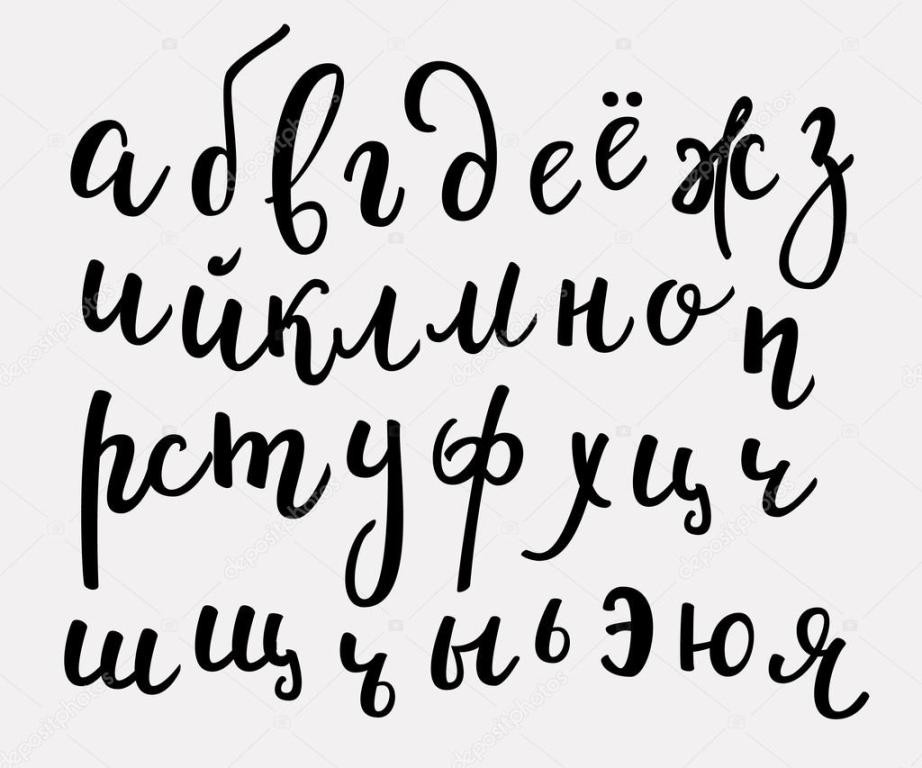Learning the Russian alphabet, also known as the Cyrillic alphabet, might seem daunting initially, but with the right approach, it’s entirely achievable. At LEARNS.EDU.VN, we break down the process into manageable steps, offering a structured path to mastering this fundamental aspect of the Russian language. Unlock effective strategies, practice tips, and resources to confidently navigate the Cyrillic script and open doors to a world of Russian language and culture.
1. Understanding the Importance of Learning the Russian Alphabet
Why is learning the Russian alphabet so crucial? While some language learners might prioritize speaking, mastering the Cyrillic script is essential for deeper engagement with the Russian language.
1.1 Unlocking Access to Authentic Resources
Imagine trying to learn Russian without being able to read Russian books, newspapers, or online articles. Grammar books and dictionaries designed for serious learners rarely offer transcriptions. In Russia, you’ll find that street signs and other public information are almost exclusively in Cyrillic. Knowing the alphabet allows you to:
- Read Russian literature in its original form.
- Use Russian dictionaries and grammar resources effectively.
- Navigate everyday life in Russian-speaking environments.
- Access a wealth of online content and learning materials.
1.2 Overcoming the Initial Barrier
Many beginners feel intimidated by the unfamiliar letters of the Cyrillic alphabet. However, this initial hurdle is often the biggest obstacle. Once you become familiar with the script, you’ll realize that Russian grammar and vocabulary are more accessible than you initially thought.
1.3 Laying a Solid Foundation
Learning the Russian alphabet is not just about recognizing letters; it’s about building a strong foundation for future language learning. It improves your reading comprehension, pronunciation, and overall understanding of the Russian language system.
Quote: “The Cyrillic alphabet is the key that unlocks the door to the rich cultural heritage and linguistic landscape of Russia.” – Irina Petrova, Professor of Slavic Languages, Moscow State University.
2. Decoding the Russian Alphabet: A Letter-by-Letter Guide
The Russian alphabet consists of 33 letters, encompassing vowels, consonants, and two signs that don’t have sounds themselves. Let’s break them down into manageable categories:
2.1 Familiar Faces: Letters Similar to English
These letters look and sound almost identical to their English counterparts, providing an easy entry point into the Cyrillic alphabet:
| Russian Letter | Pronunciation (IPA) | English Equivalent | Example (Approximate) |
|---|---|---|---|
| А а | /ɑː/ | a | father |
| Е е | /je/ | ye | yes |
| К к | /k/ | k | kit |
| М м | /m/ | m | man |
| О о | /o/ | o | fort (stressed) |
| Т т | /t/ | t | top |




2.2 Tricky Look-Alikes: Letters with Different Sounds
These letters resemble English letters but have entirely different pronunciations. Mastering these is crucial to avoid confusion:
| Russian Letter | Pronunciation (IPA) | English Equivalent | Example (Approximate) |
|---|---|---|---|
| С с | /s/ | s | sit |
| Р р | /r/ | r | run (rolled) |
| Х х | /x/ | h | hello |
| Н н | /n/ | n | no |
| В в | /v/ | v | vet |
| У у | /u/ | oo | boot |
2.3 New Friends: Unique Russian Letters with Familiar Sounds
These letters might look unfamiliar, but their sounds exist in English. This makes them relatively easy to learn:
| Russian Letter | Pronunciation (IPA) | English Equivalent | Example (Approximate) |
|---|---|---|---|
| Б б | /b/ | b | boy |
| Д д | /d/ | d | dog |
| З з | /z/ | z | zoo |
| Г г | /ɡ/ | g | go |
| П п | /p/ | p | pen |
| Ф ф | /f/ | f | fun |
| Л л | /l/ | l | lap |
| И и | /i/ | ee | see |
2.4 Unique Sounds: Mastering the Distinctly Russian Letters
These letters represent sounds that don’t have direct equivalents in English. They require focused practice and attention:
| Russian Letter | Pronunciation (IPA) | Description | Example (Approximate) |
|---|---|---|---|
| Я я | /ja/ | Similar to “ya” in “yard” | yard |
| Й й | /j/ | Similar to “y” in “boy” | boy |
| Э э | /ɛ/ | Similar to “e” in “edit” | edit |
| Ю ю | /ju/ | Similar to “you” | you |
| Ё ё | /jo/ | Similar to “yo” in “yonder” (often written as Е е) | yonder |
| Ы ы | /ɨ/ | No direct English equivalent; a sound between “i” in “bit” and “oo” in “book” | (Listen to audio examples) |
| Щ щ | /ɕː/ | Similar to “shch” (a prolonged “sh” sound followed by a slight “ch” sound) | (Listen to audio examples) |
2.5 Double Trouble: Letters Representing Two-Letter Sounds
These letters represent sounds that are typically written with two letters in English:
| Russian Letter | Pronunciation (IPA) | English Equivalent | Example (Approximate) |
|---|---|---|---|
| Ч ч | /tʃ/ | ch | church |
| Ж ж | /ʒ/ | zh | pleasure |
| Ш ш | /ʃ/ | sh | shut |
| Ц ц | /ts/ | ts | sits |
2.6 The Silent Partners: Signs That Modify Sounds
These signs don’t have sounds of their own, but they significantly impact the pronunciation of the letters around them:
| Russian Letter | Function | Example |
|---|---|---|
| Ъ ъ | Hard sign: Creates a pause between syllables and prevents palatalization | съезд (s”yezd” – congress) |
| Ь ь | Soft sign: Makes the preceding consonant softer (palatalized) | соль (sol’ – salt) |
Key Takeaway: While the Russian alphabet might seem overwhelming at first, breaking it down into these categories makes the learning process more manageable. Focus on mastering each group of letters before moving on to the next.
3. Vowels: The Heart of Russian Pronunciation
Russian has ten vowels, plus the semi-vowel Й. Understanding how vowels work is key to accurate pronunciation.
3.1 Hard and Soft Vowels
Many Russian vowels have two forms: a hard form and a soft form. The soft form indicates that the preceding consonant is palatalized (pronounced with the tongue touching the roof of the mouth).
| Hard Vowel | Soft Vowel | Effect on Preceding Consonant |
|---|---|---|
| А | Я | Palatalizes the consonant |
| Э | Е | Palatalizes the consonant |
| У | Ю | Palatalizes the consonant |
| О | Ё | Palatalizes the consonant |
Note: The letters Ы and И are also vowels, but they don’t have hard/soft pairs.
3.2 The Role of Stress
Stress plays a crucial role in Russian pronunciation. Unstressed vowels often undergo reduction, meaning they are pronounced differently than their stressed counterparts.
Example: The letter “O” is pronounced as /o/ when stressed, but it can be pronounced as /ə/ (like the “a” in “about”) or even disappear entirely when unstressed.
Expert Tip: Pay close attention to the placement of stress in Russian words. It can significantly affect pronunciation and meaning.
4. Practical Strategies for Mastering the Russian Alphabet
Learning the Russian alphabet requires consistent effort and the right strategies. Here are some proven techniques to accelerate your progress:
4.1 Start with the Basics
Begin by focusing on the letters that are similar to English. This will give you a sense of accomplishment and build momentum. Gradually introduce the more challenging letters as you become more comfortable.
4.2 Use Flashcards
Create flashcards for each letter, including its pronunciation, English equivalent (if any), and an example word. Review the flashcards regularly to reinforce your memory.
4.3 Practice Writing
Writing the letters by hand helps to solidify your understanding of their forms. Practice writing individual letters, then move on to writing simple words and phrases.
4.4 Read Aloud
Find simple Russian texts, such as children’s books or online articles for beginners, and read them aloud. This will help you to improve your pronunciation and reading fluency.
4.5 Use Online Resources
There are many excellent online resources for learning the Russian alphabet, including:
- Apps: Duolingo, Memrise, Anki
- Websites: LEARNS.EDU.VN, MasterRussian.com, RussianPod101
- YouTube channels: Russian with Max, Real Russian Club
4.6 Immerse Yourself in the Language
Surround yourself with the Russian language as much as possible. Listen to Russian music, watch Russian movies and TV shows (with subtitles), and try to find opportunities to speak with native Russian speakers.
University Research: A study by the University of California, Berkeley, found that students who used a combination of flashcards, writing practice, and reading aloud were significantly more successful in learning the Russian alphabet than those who relied solely on one method.
5. Essential Tools and Resources for Your Learning Journey
To maximize your learning potential, consider utilizing these helpful tools and resources:
5.1 Russian Keyboard
Investing in a Russian keyboard (either a physical keyboard or a virtual keyboard app) will make it much easier to practice writing in Russian.
5.2 Russian Dictionary
A good Russian-English dictionary is essential for looking up unfamiliar words and understanding their meanings.
5.3 Language Exchange Partner
Finding a language exchange partner who speaks Russian can provide invaluable opportunities for practice and feedback.
5.4 Online Courses and Tutorials
LEARNS.EDU.VN offers a variety of online courses and tutorials designed to help you learn the Russian alphabet and improve your overall Russian language skills.
6. Common Challenges and How to Overcome Them
Learning the Russian alphabet can be challenging, but with the right approach, you can overcome these obstacles:
6.1 Difficulty Distinguishing Similar Letters
Challenge: Confusing letters like С с and Р р, or Н н and В в.
Solution: Focus on the subtle differences in their shapes and pronunciations. Use flashcards and practice writing them repeatedly.
6.2 Mastering the Unique Russian Sounds
Challenge: Pronouncing sounds like Ы ы and Щ щ, which don’t have direct English equivalents.
Solution: Listen to audio examples and try to imitate the sounds as closely as possible. Use online pronunciation guides and seek feedback from native speakers.
6.3 Remembering All the Letters
Challenge: Feeling overwhelmed by the sheer number of letters in the Russian alphabet.
Solution: Break the alphabet down into smaller groups and focus on mastering one group at a time. Use spaced repetition techniques to reinforce your memory.
Success Story: Maria, a student at LEARNS.EDU.VN, initially struggled with the Russian alphabet. By using flashcards, practicing writing, and working with a language exchange partner, she was able to master the alphabet in just a few weeks.
7. Integrating the Russian Alphabet into Your Language Learning Routine
Once you’ve learned the basics of the Russian alphabet, it’s important to integrate it into your regular language learning routine. Here are some ideas:
7.1 Label Everything
Label objects around your home with their Russian names written in Cyrillic. This will help you to associate the letters with their corresponding words.
7.2 Read Russian News
Read Russian news websites or online articles to stay up-to-date on current events and improve your reading comprehension.
7.3 Write in Russian
Keep a journal in Russian, write emails to Russian-speaking friends, or participate in online Russian forums.
7.4 Watch Russian Movies and TV Shows
Watch Russian movies and TV shows with subtitles (initially) to improve your listening comprehension and vocabulary.
8. Why Choose LEARNS.EDU.VN for Your Russian Language Journey?
At LEARNS.EDU.VN, we are committed to providing high-quality, effective, and engaging language learning resources. Here’s what sets us apart:
8.1 Expert-Designed Curriculum
Our Russian language courses are designed by experienced educators and linguists who understand the challenges that learners face.
8.2 Interactive Learning Materials
We offer a variety of interactive learning materials, including videos, audio recordings, quizzes, and exercises, to keep you engaged and motivated.
8.3 Personalized Learning Experience
We provide personalized feedback and support to help you achieve your language learning goals.
8.4 Community Support
Join our online community of Russian language learners to connect with other students, share your experiences, and get support.
9. The Future of Russian Language Learning: Trends and Innovations
The field of language learning is constantly evolving, with new technologies and methodologies emerging all the time. Here are some of the key trends and innovations shaping the future of Russian language learning:
| Trend/Innovation | Description | Benefits |
|---|---|---|
| AI-Powered Language Learning | Using artificial intelligence to personalize learning, provide real-time feedback, and generate customized learning materials. | More efficient and effective learning, tailored to individual needs and learning styles. |
| Virtual Reality (VR) Immersion | Immersing learners in virtual Russian-speaking environments to simulate real-life interactions and cultural experiences. | Enhanced cultural understanding, improved speaking skills, and increased motivation. |
| Gamification | Incorporating game-like elements into language learning to make it more engaging and fun. | Increased motivation, improved retention, and a more positive learning experience. |
| Mobile Learning | Learning on the go using mobile apps and devices. | Greater flexibility and convenience, allowing learners to study anytime, anywhere. |
Quote: “The future of language learning is personalized, immersive, and accessible to everyone.” – Dr. Elena Ivanova, Professor of Educational Technology, St. Petersburg State University.
10. Frequently Asked Questions About Learning the Russian Alphabet
Here are some frequently asked questions about learning the Russian alphabet:
Q1: How long does it take to learn the Russian alphabet?
A: Most learners can master the basics of the Russian alphabet in a few weeks with consistent effort.
Q2: Is it necessary to learn the Russian alphabet before starting to learn grammar and vocabulary?
A: Yes, learning the alphabet is essential for reading and writing in Russian, which are crucial for building a strong foundation in the language.
Q3: What is the best way to memorize the Russian alphabet?
A: A combination of flashcards, writing practice, reading aloud, and using online resources is the most effective way to memorize the Russian alphabet.
Q4: Are there any letters in the Russian alphabet that are particularly difficult to learn?
A: Letters like Ы ы and Щ щ, which don’t have direct English equivalents, can be challenging for some learners.
Q5: Do I need to learn cursive Russian?
A: While it’s not essential for beginners, learning cursive Russian is helpful for reading handwritten texts and communicating with native speakers.
Q6: What is the difference between the hard sign (ъ) and the soft sign (ь)?
A: The hard sign indicates a pause between syllables and prevents palatalization, while the soft sign makes the preceding consonant softer (palatalized).
Q7: How important is pronunciation when learning the Russian alphabet?
A: Pronunciation is very important. Pay close attention to the sounds of the letters and try to imitate them as closely as possible.
Q8: Can I learn the Russian alphabet using only online resources?
A: Yes, there are many excellent online resources for learning the Russian alphabet, but it’s also helpful to use other methods, such as flashcards and writing practice.
Q9: Is it possible to learn the Russian alphabet on my own?
A: Yes, it is possible to learn the Russian alphabet on your own, but it can be helpful to have a teacher or language exchange partner to provide feedback and support.
Q10: What are some common mistakes that learners make when learning the Russian alphabet?
A: Common mistakes include confusing similar letters, mispronouncing the unique Russian sounds, and neglecting to practice writing the letters.
Mastering the Russian alphabet opens doors to a vibrant culture and a world of new opportunities. Start your journey today with LEARNS.EDU.VN!
Ready to embark on your Russian language adventure? Visit LEARNS.EDU.VN today to explore our comprehensive courses and resources! Unlock your potential and discover the joy of learning Russian with us. Contact us at 123 Education Way, Learnville, CA 90210, United States or Whatsapp: +1 555-555-1212. Let learns.edu.vn be your guide to fluency!